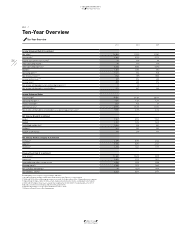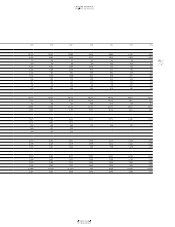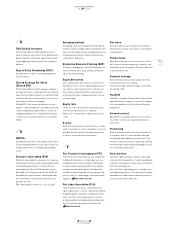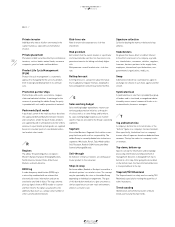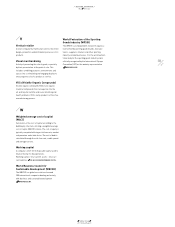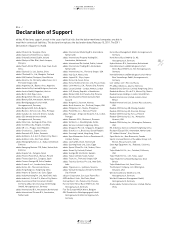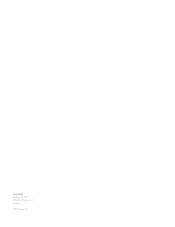Reebok 2011 Annual Report Download - page 236
Download and view the complete annual report
Please find page 236 of the 2011 Reebok annual report below. You can navigate through the pages in the report by either clicking on the pages listed below, or by using the keyword search tool below to find specific information within the annual report.
adidas Group
2011 Annual Report
ADDITIONAL INFORMATION
232
2011
05.2 Glossary
05.2
Private investor
Individual who invests his/her own money in the
capital market, as opposed to an institutional
investor.
Private placement
Placement of debt securities directly to institutional
investors, such as banks, mutual funds, insurance
companies, pension funds and foundations.
Product Life Cycle Management
(PLM)
Product life cycle management is a systematic
approach to managing the life cycle of a product,
from its design and development to its ultimate
sale.
Promotion partnerships
Partnerships with events, associations, leagues,
clubs and individual athletes. In exchange for the
services of promoting the adidas Group, the party
is provided with cash and/or promotional material.
Push model/pull model
A push-pull system in the retail business describes
the supply and demand dynamic between retailers
and consumers. Under the push model, products
are supplied based on anticipated customer orders,
whereas in a pull model system goods are supplied
based on consumer point-of-sale demand and ac-
tual market sales trends.
R
Regions
The adidas Group distinguishes six regions:
Western Europe, European Emerging Markets,
North America, Greater China, Other Asian
Markets and Latin America.
RFID tag
A radio-frequency identification (RFID) tag is
a microchip combined with an antenna that
electronically stores information and can be
attached to any kind of object. The tag’s antenna
picks up signals from an RFID reader or scanner
and then returns the signal, usually with some
additional data (such as a unique serial number or
other customised information).
Risk-free rate
Rate of return to be expected on a risk-free
investment.
Risk premium
Extra return that the overall market or a particular
stock must provide over the risk-free rate to com-
pensate an investor for taking a relatively higher
risk.
Risk premium = overall market rate – risk-free
rate.
Rolling forecast
A rolling forecast is a projection about the future
that is updated at regular intervals, keeping the
forecasting period constant (e.g. twelve months).
S
Sales working budget
Sales working budget expenditures relate to ad-
vertising and promotion initiatives at the point
of sale as well as to store fittings and furniture.
As sales working budget expenses are channel-
specific, they are allocated to the Group’s operating
segments.
Segment
Also called Business Segment. Units within a com-
pany that have profit and loss responsibility. The
adidas Group is currently divided into six business
segments: Wholesale, Retail, TaylorMade-adidas
Golf, Rockport, Reebok-CCM Hockey and Other
Centrally Managed Brands.
Sell-through
An indicator of how fast retailers are selling a par-
ticular product to the consumer.
Shop-in-shop
Exclusive adidas, Reebok or Rockport area within a
wholesale partner’s or retailer’s store. The concept
may be operated by the store or the adidas Group
depending on individual arrangements. The goal
of this distribution method is to give consumers a
similar experience to an own-retail environment,
albeit on a smaller scale.
Signature collection
Collection bearing the name or the brand of top
athletes.
Stakeholders
All groups that have a direct or indirect interest
in the efforts and results of a company, e.g. lend-
ers, shareholders, consumers, retailers, suppliers,
licensees, business partners in the supply chain,
employees, international sport federations, non-
governmental organisations, media, etc.
Swap
A derivative in which two counterparties agree to
exchange one stream of cash flows against another
stream.
Syndicated loan
A syndicated loan is one that is provided by a group
of lenders and is structured, arranged and admin-
istered by one or several commercial banks or in-
vestment banks, known as arrangers.
T
Top and bottom line
A company’s bottom line is its net income, or the
“bottom” figure on a company’s income statement.
More specifically, the bottom line is a company’s
income after all expenses have been deducted from
revenues. The top line refers to a company’s sales
or revenues.
Top-down, bottom-up
Specific concept for information and knowledge
processing. Information and empowerment of
management decisions is delegated from top to
bottom in a first step. After going into more detail
on the bottom level, the final information/decision
is transported back to the top.
Toxproof/TÜV Rheinland
The Toxproof mark is a safety mark issued by TÜV
Rheinland, especially for testing the quantities of
toxins in products.
Trend scouting
Identification and commercialisation of future
trends, particularly lifestyle trends.




